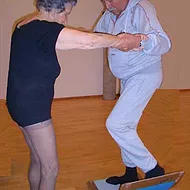by Joaquim Reverter-Masià, Dani Picó-Benet and David Ribera-Nebot

Health in the Elderly with T-BOW®
The T-BOW® with its special characteristics (arc with stable-unstable convexity and unstable concavity, very robust but with very high reactivity to the finest movements, narrow edges for precise supports and side holes to place elastic bands) will allow a multitude of differential workouts for health in elderly people. In addition to the maintenance of general physical form and a well-structured muscular-articular reinforcement, the strength for posture control and coordination improvement to achieve more security in situations of balance and rebalancing are important health criteria in the 3rd age, and can be enhanced in an optimal and fun way with T-BOW®, both in more personalized situations and in group activities also encouraging socio-a
Optimization of static and dynamic balances
The stable position of the T-BOW® with its convex surface allows a multitude of support for feet, knees, hands and forearms, up-down actions and mini-jumps adopting a wide variety of static and dynamic postures. The unstable position of the T-BOW® allows high reactivity balances in both foot and hand support, a situation that apart from optimizing static-dynamic balances also stimulates postural adjustments. Balances with support of the feet on the lateral edges are of particular importance to enhance the bilateral control of the muscles of the foot and at the same time stabilize with high sensitivity all the muscles that maintains the longitudinal axis of the leg, thanks to the functional screwing from the foot to the hip that is forced by this swing on the lateral edges of the T-BOW®.

The swings in support of the hands will provide reactivity and stabilization to the shoulder and the entire shoulder girdle. The T-BOW® allows hand supports on an inclined plane or on its side edges that significantly reduce the overload on the wrists.

Practical training experiences with varied and unstable platforms in elderly individuals show very significant improvements at the level of the neuromuscular reflex system, a very determining factor for postural control and balance. With these types of training, the control-regulation of the actions of daily life will improve and the risk of falls will be reduced.
Optimization of strength and postural control
The convex surface of T-BOW® in a stable position allows a greater range of movement of the spine along with a stable anatomical support that allows better muscle location; achieving a reinforcement of the muscles of the front, lateral and posterior trunk differentiating parts and globally, in very healthy amplitude and with high precision. The swinging situations with high reactivity that T-BOW® allows, with the possibility of asymmetric free loads, are ideal for strengthening the back and joint stability (deep muscle). Likewise, with the T-BOW® you can design strength exercises for the entire muscles of the body, from very specific exercises to more global actions, both in stable conditions and in very reactive and safe balancing conditions. The use of T-Bands will allow a variety of contractions and at the same time very effective alternatives for segmental and global postural control.
Optimization of flexibility
The convex surface of the T-BOW®, both in a stable and unstable situation, optimates the mobility of the spine in an extraordinary way, allowing a greater range of movement than a flat surface and stable and sensitive support for all areas of the back. When sitting on the T-BOW® raises the hip and facilitates joint mobility and stretching of the hip and leg muscles. The musculature of the calf and foot can be stretched effectively and comfortably by taking advantage of the curvature of the T-BOW®.

Optimization of affectivity
The T-BOW® allows shared swings and mini-group games that will allow multiple alternatives to optimize the socio-affective situations of mutual help and cooperation of elderly people, a fundamental aspect of their emotionality and holistic health.
Authors:
Joaquin Reverter-Masià is co-coordinator of EEB Sport Training Barcelona, Doctor of Human Motor Sciences and Professor of Human Motor Science - Universities of Zaragoza and Lleida.
Daniel Picó-Benet is co-coordinator of EEB Sport Training Barcelona, Doctor of Human Motor Sciences and Professor of Human Motor Science at the Ramon Llull University of Barcelona.
David Ribera-Nebot, is co-coordinator of EEB Sport Training Barcelona, Doctor of Human Motor Sciences and Associate Professor of Human Motor Skills at the University of Lleida.









































Comments